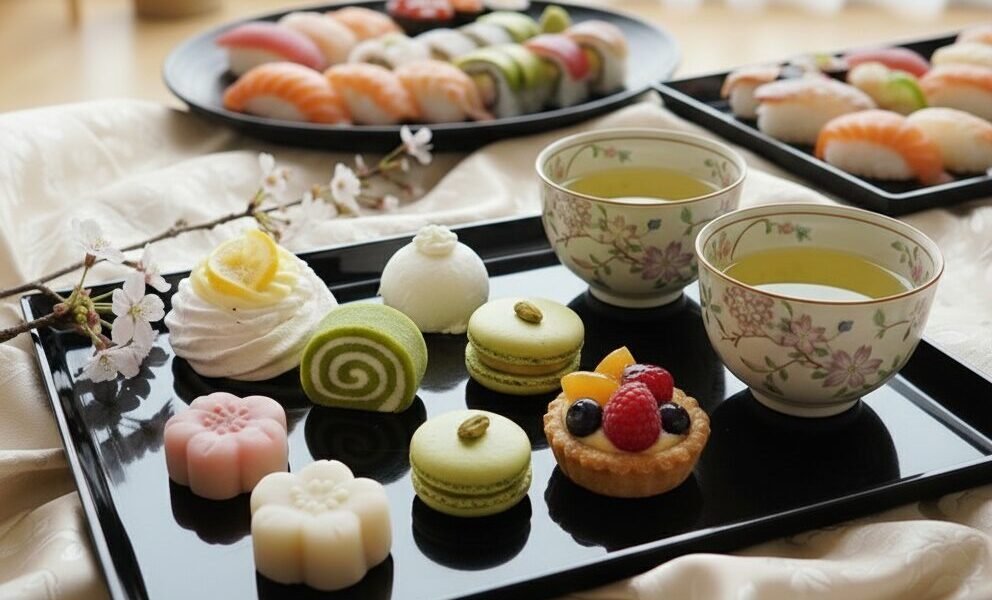
Green Tea Food Pairing: How to Pair Green Tea with Meals
Index
Ever found yourself brewing a perfect cup of green tea, then wondering what snack might go with it?
Green tea’s grassy, umami-rich profile can transform an ordinary meal into something memorable when you know which foods bring out its best qualities.
This guide will walk you through the exact pairings and the science behind why they work.
Key Takeaways
- Green tea’s grassy, umami, and lightly astringent flavors enhance light meals, seafood, vegetables, delicate desserts, and classic Japanese dishes like sushi and tempura.
- Sencha pairs best with sushi or grilled fish; Gyokuro’s rare umami flavor (representing less than 0.3% of Japan’s production) matches soy sauce-rich foods and parmesan cheese.
- Pair green tea varieties such as Dragon Well with seafood or mild pastries to highlight the tea’s nutty notes without overpowering its subtle aroma.
- Avoid pairing green tea with greasy meats, strong spices, or sweet chocolates since these overpower the drink’s clean taste.
- Research confirms amino acids like Theanine drive green tea’s sweetness and umami; optimal brewing is between 160°F-185°F (71–85°C) for 1-3 minutes to preserve key flavors. For very delicate Japanese green teas (such as gyokuro) consider using lower temperatures like 140–160°F (60–71°C).
What Are the Flavor Characteristics of Green Tea?
Green tea brings a mix of grassy notes, gentle sweetness, and light astringency that set it apart from black tea or oolong.
Understanding these subtle flavors helps you pair tea with different foods and enjoy a richer tasting experience.
Despite its name, brewed green tea appears as a translucent pale yellow to light green liquid rather than a deep green color. Most varieties produce a golden or yellowish-green hue in the cup. The exceptions are matcha, which maintains its vibrant green color when whisked into water, and shade-grown teas like gyokuro that can show a slightly deeper green tint due to their higher chlorophyll content.
Grassy and Vegetal Notes
Grassy and vegetal notes define many Japanese green teas, including sencha, gyokuro, and matcha.
Sencha stands out with its grassy flavor and medium bitterness, creating a refreshing mouthfeel that tea enthusiasts prize. Japanese green teas also carry seaweed-like aromas due to how the Camellia sinensis leaves are steamed after harvest. These flavors often remind people of fresh-cut grass, sweet pea shells, or even nori sheets from sushi rolls.
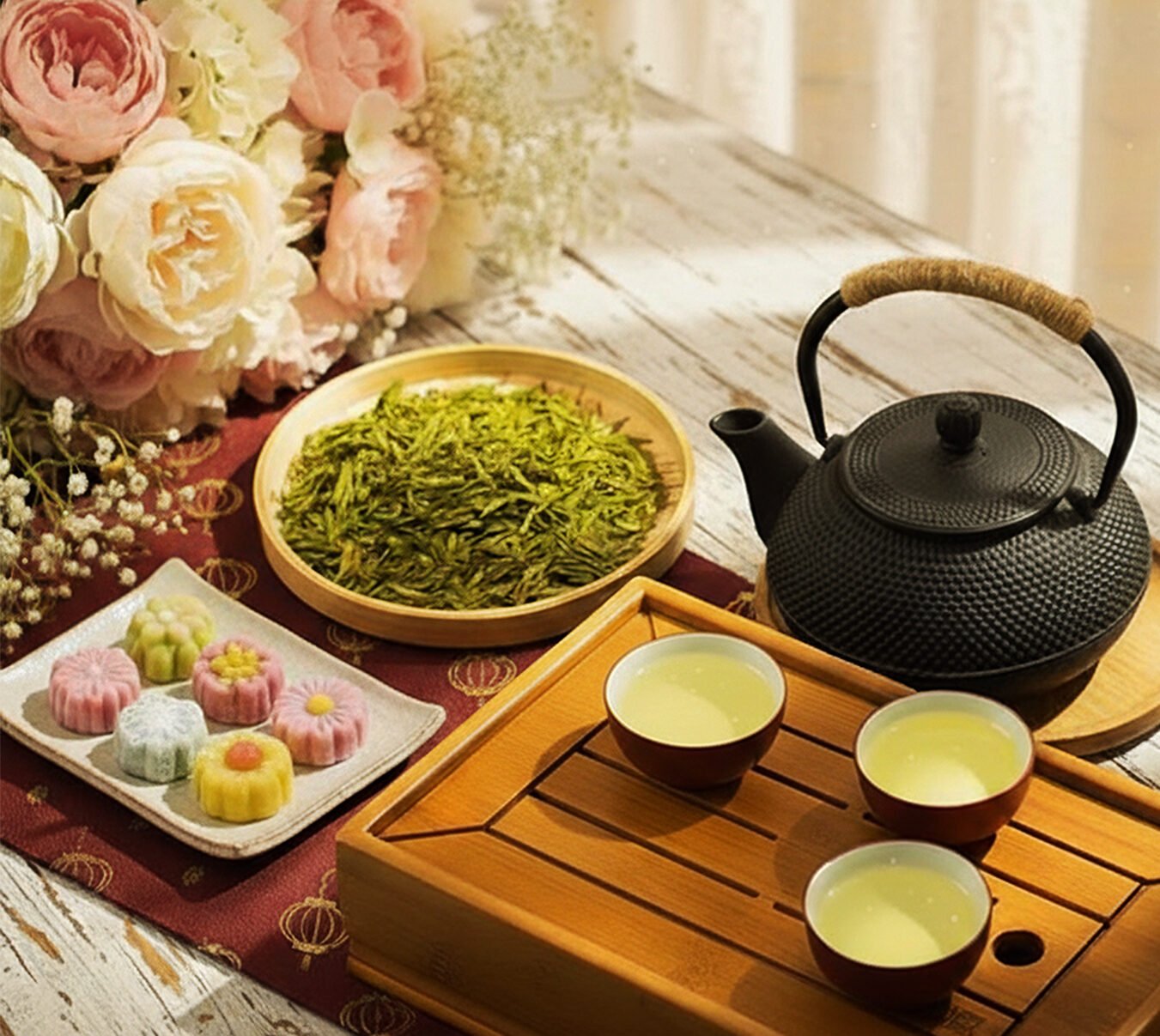
You know what I’ve learned from testing storage methods?
Storing loose leaf tea for no longer than 6 to 9 months helps keep its grassy taste vivid and lively. Tea connoisseurs know the correct brewing temperature preserves these bright notes. Brew between 160°F (~70°C) and 185°F (~85°C) for best results, and steep for 1 to 3 minutes so the vegetal profile stays pronounced without becoming overly bitter or harsh.
Cold-brewed Dragon Well from China often appeals to beginners for its delicate grassy hint, making it a gentle entry into these classic tea flavors.
Umami and Sweetness
Amino acids like Theanine and Glutamic Acid give green tea its signature umami flavor and natural sweetness.
According to a 2025 review in Trends in Food Science & Technology, theanine typically constitutes approximately 0.9–2% of tea’s dry weight, contributing to around 50–70% of the total free amino acid content in tea leaves. Japanese tea growers use light-wave fixation to create a sweeter and mellower taste, making teas like Gyokuro shine with umami.
In contrast, roller fixation increases bitterness, causing teas to lose much of their perceived sweetness and reducing their umami flavor profile.
Researchers identified 97 differential metabolites in green tea that link directly to taste quality, confirming how science backs the art of pairing tea with food.
Sensory studies show strong correlations between these compounds, especially amino acids, and the experience of both umami and sweetness on the palate. Teas rich in Theanine tend to pair well with foods high in umami themselves. Think savory seafood or creamy eggs. This creates a match made in heaven for any food and tea pairing enthusiast.
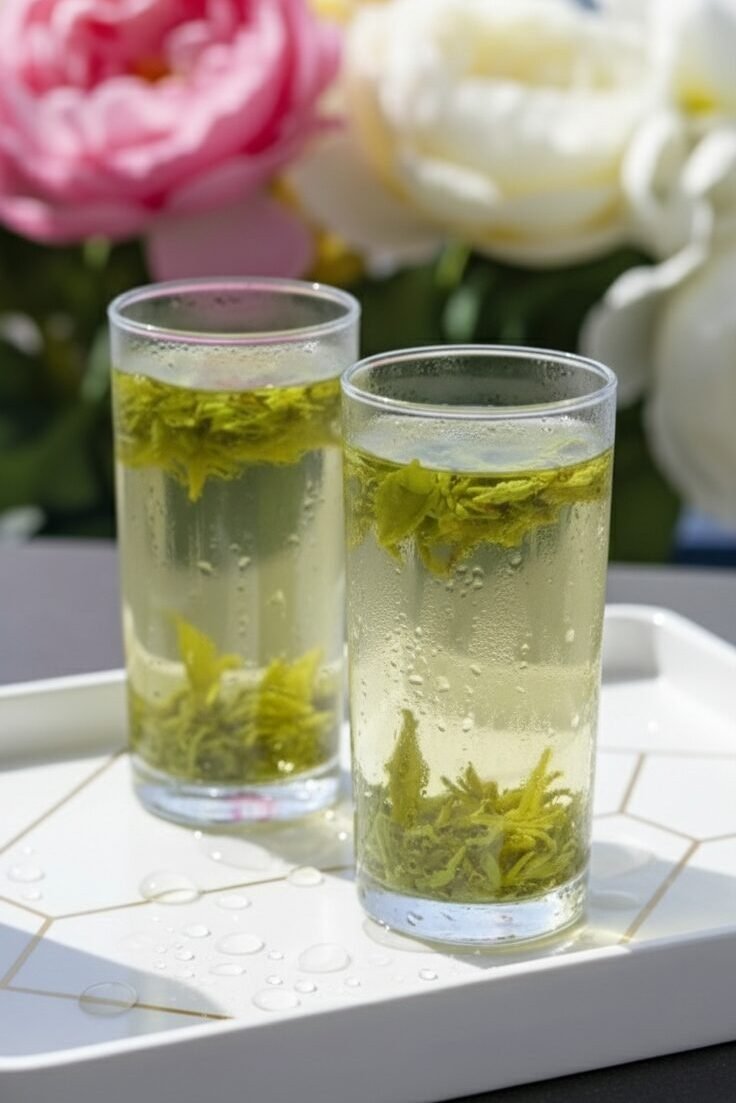
Processing methods affect both the sweetness and overall aroma of green tea leaves. Higher amino acid content results in a smoother sip with less bite on the aftertaste. This makes such teas ideal for dishes where subtle flavors are important rather than bold spices or deep roasting.
Light Astringency
Catechins act as the main astringent and slightly bitter compounds in green tea, shaping its unique mouthfeel and flavor.
A 2018 study in Food Chemistry found that gallate-type catechins such as epigallocatechin gallate (EGCG) and epicatechin gallate (ECG) showed the highest correlations with bitterness and astringency in green tea infusions. Summer green tea in particular shows higher levels of these catechins, resulting in a stronger astringent sensation on the tongue than spring or autumn harvests.
After fermentation, green tea develops a more mellow and fragrant profile with a sweet aftertaste and moderate acidity, which sensory testing confirms.
Light astringency allows food pairings to shine without overwhelming the palate. Slightly bitter green tea balances the taste of mild snacks such as rice crackers, fruit salads, or delicate pastries. In Japanese tea ceremonies, the subtle puckering effect prepares taste buds for wagashi sweets or even light sandwiches.
What Foods Pair Best with Green Tea?
Green tea pairings highlight its grassy and umami flavors, letting the tea balance both sweet and savory dishes.
Exploring teas and food together encourages you to try pairing different flavors for an elevated tea time.
Green Tea with Light Meals

Pairing teas and food creates a balanced dining experience.
Fruity or floral green teas match well with light sandwiches, fresh salads, and crusty bread. Many tea drinkers also find that pairing these teas with crackers enhances the grassy notes naturally present in vegetal green teas.
For those who enjoy Japanese cuisine, combining a cup of Sencha or Gyokuro with onigiri rice balls or simple vegetable sushi rolls allows distinct flavors to shine without overpowering the delicate tea aroma.
Light meals such as turkey breast sandwiches or mild cheese and buttered toast complement a gentle infusion of white tipped oolong or even a classic matcha latte.
Tea parties often feature this combination by serving scones, macarons, and pastry bites for both hungry guests and casual drinkers alike. Choosing lighter fare not only makes it easier for your palate to enjoy the unique taste of tea but can also support healthier eating habits compared to heavier meal options.
Green Tea with Seafood
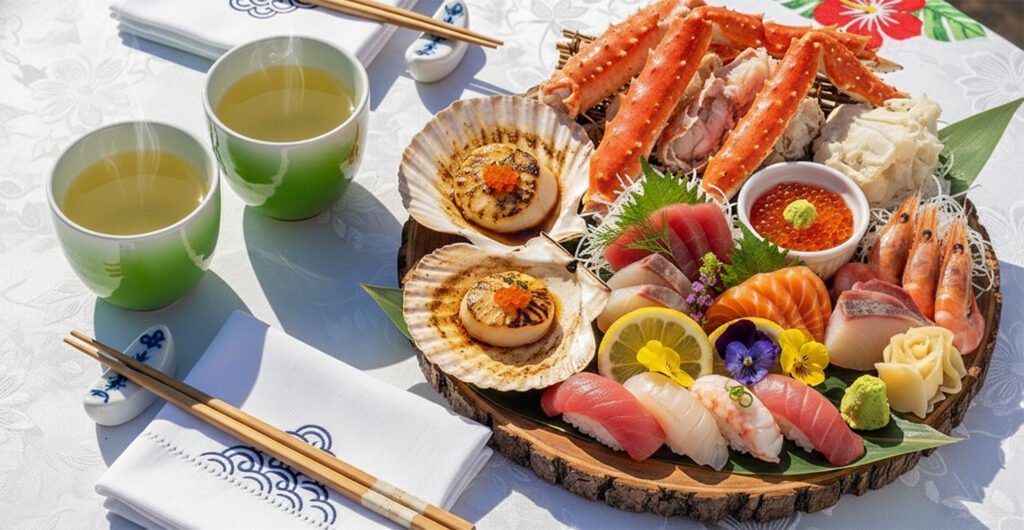
Sencha, a classic Japanese green tea, matches well with seafood because of its grassy and vegetal notes.
Sushi, crabs, and lobsters taste cleaner and richer when sipped with bright green tea. Salmon, in particular, brings out the tea’s seaweed-like aroma, blending the flavors naturally. According to pairing experts at Mizuba Tea, seafood and umami-rich foods like shiitake mushrooms, oysters, tuna, and seaweed make a lovely pair with Sencha Yabukita and Saemidori cultivars.
Not every seafood works well, however. Scallops with corn and merguez salsa cover up the delicate tea flavors. To achieve harmony, choose seafood dishes that are gently seasoned.
Japanese food traditions show that green tea and seafood create a balanced pairing, especially during a Japanese tea ceremony.
Green Tea with Vegetables

The grassy and earthy notes in green tea enhance the natural flavor of greens like bok choy, spinach, or tender asparagus.
Lightly sautéed or steamed vegetables stand out beside hot Japanese teas, especially those with a green hue such as gyokuro or Dragon Well. These combinations echo traditional Japanese cuisine, where pairing green tea with vegetables is common practice for both taste and health.
Vegetarian dishes, mixed salads, and even root vegetables benefit from the balance that a good cup of malty or lightly smoky green tea delivers.
Dishes like light stir-fry, sesame-crusted vegetables, and tomato-based recipes become more vibrant with a fragrant pour. Research shows that pairing food with tea may boost nutritional absorption while amplifying sweet and umami flavors on your palate.
Green Tea with Delicate Desserts
Green tea brings out the subtle sweetness in almond croissants or a fruit tart while its grassy notes provide balance to the sugar content.
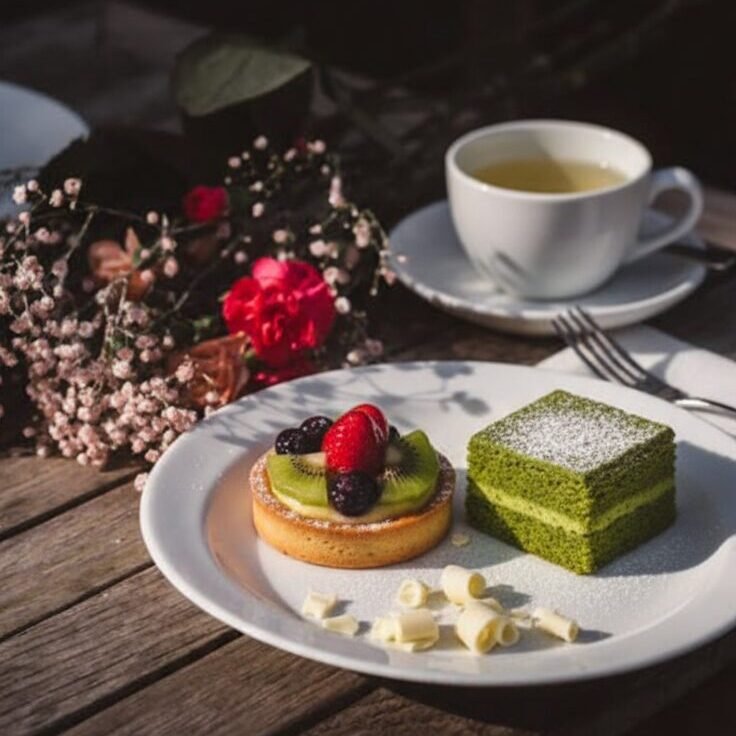
According to a 2024 analysis by Tastewise, matcha dessert pairings are trending with white chocolate, strawberries, and vanilla emerging as the top three flavor combinations in cafés globally. Pairing green tea with cake or mild pastries like scones makes each bite feel less heavy. The flavor of matcha in pastries or mochi matches the vegetal aroma of the tea itself.
Drinking green tea as you eat sweets such as white chocolate or light sponge cakes cuts through the richness.
Both casual drinkers and food enthusiasts also discover that teas like sencha or gyokuro highlight delicate fruits such as pear or apple found in tarts. Antioxidants in green tea help moderate sugar intake according to nutrition studies.
Which Green Tea Varieties Pair with Which Foods?
Each green tea variety interacts with food flavors in distinct ways, much like wine pairing.
Let me show you how aroma, matcha flavor, and even oolong tea character influence which dishes you can enjoy side-by-side with your cup.
Sencha Food Pairing
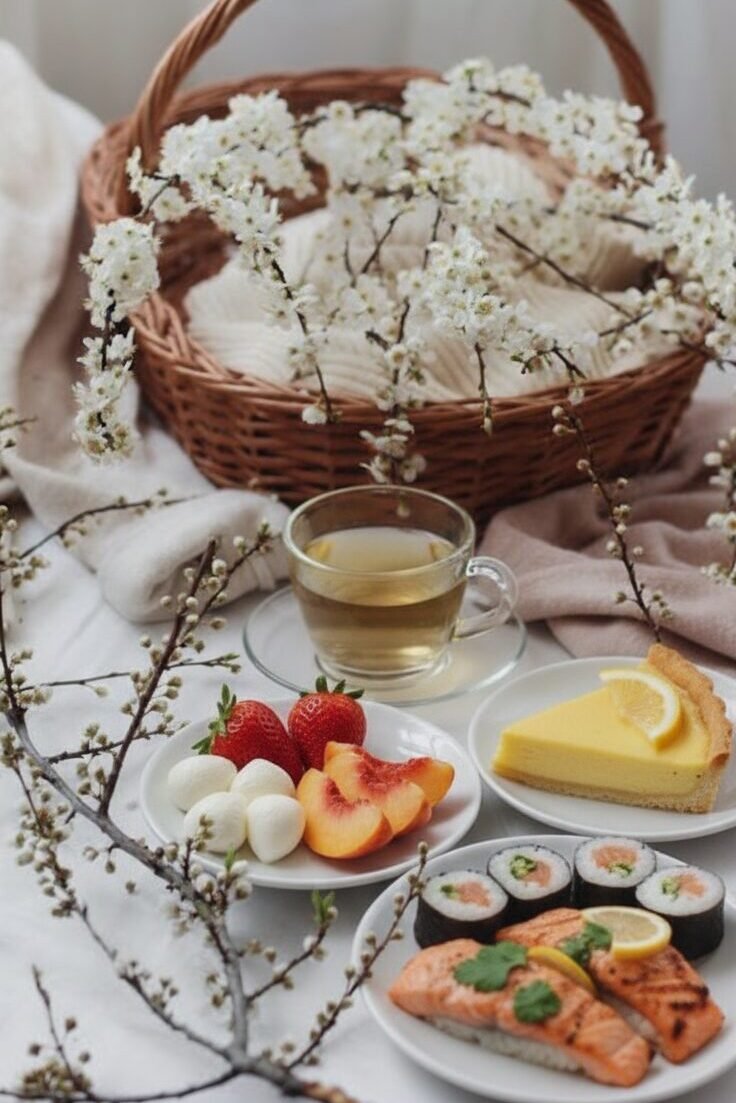
Sencha, with its grassy aroma and medium bitterness, pairs best with clean flavors.
According to tea experts at Ippodo Tea, Sencha makes up over 70% of tea consumption in Japan, delivering a harmonious balance of umami, astringency, sweetness, and bitterness. Sushi, sashimi, and grilled fish like mackerel or salmon let Sencha’s freshness shine. In Japan, people often drink this tea with traditional rice crackers and light tempura, creating a harmony similar to wine and food pairing traditions.
Sencha also brings out the sweetness in fruits such as strawberries or peaches, making it a great companion to fresh fruit plates.
Light salads with cucumber or radish offer a pleasant contrast, balancing Sencha’s slight astringency. Seasonal ingredients lift both the tea and the meal, so spring salads or summer citrus desserts work well here too. For dessert, try flaky pastries or mild sweets. Avoid bold flavors that would overpower the tea.
To follow the principles of tea and cheese pairing ideas, try mild cheeses such as fresh mozzarella or ricotta next to Sencha for an interesting twist on tradition.
Avoid dishes heavy with garlic or smoky barbecue as these can mask Sencha’s delicate notes.
Gyokuro Food Pairing
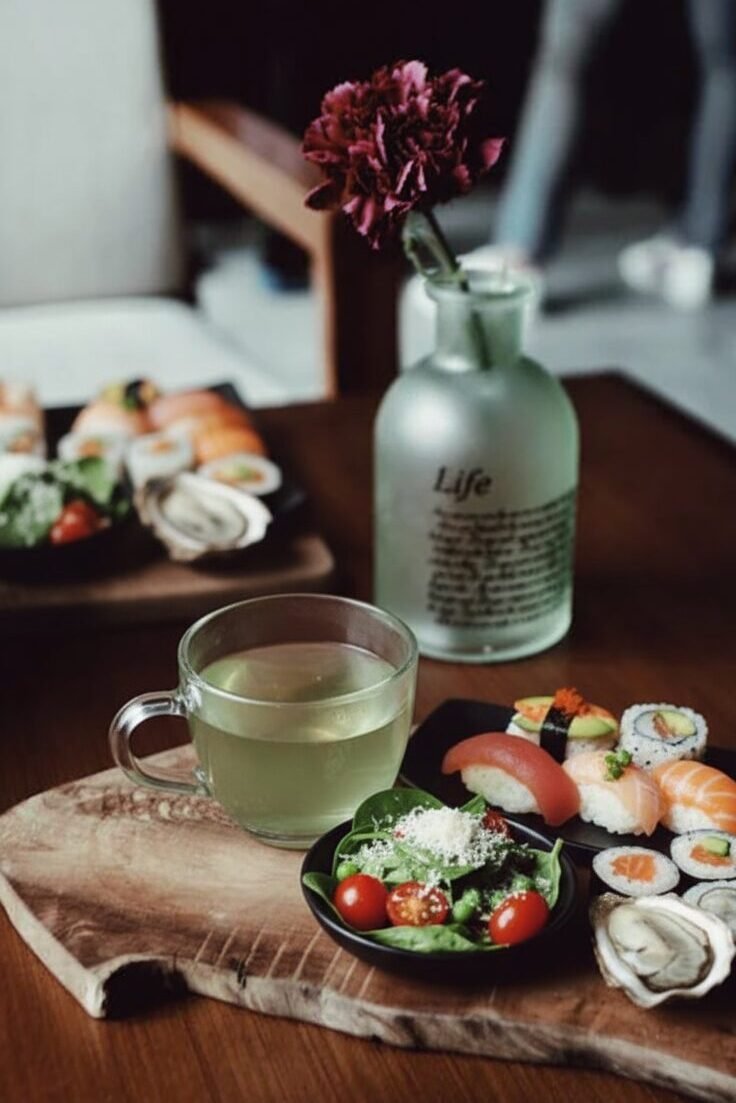
Gyokuro, which accounts for less than 0.3% of Japanese green tea production, offers a rare and deep umami flavor.
According to cultivation research from SONO Organic, shaded growing methods preserve significantly more amino acids and caffeine in Gyokuro compared to Sencha or Tamaryokucha. This makes it perfect for special dinner parties or luxurious treats. Its sweet pear notes, light citrus aroma, and hints of sweet pea and baked peach pair tea with food that is also high in umami, such as soy sauce, parmesan cheese, oysters, tuna, and sushi.
This tea also pairs well with vegetables like tomatoes, peas, garlic, corn, and spinach, enhancing both the green color and depth of flavor in the meal.
Tea will balance the richness of dark chocolate and complements mild sweets. High-quality Gyokuro, served with proper Japanese tea ware, creates a unique sense data experience for tea enthusiasts. Gyokuro also pairs beautifully with delicate desserts and offers a toasty, sweet finish.
Dragon Well Food Pairing
Dragon Well green tea brings a sweet, nutty taste with slight vegetal notes and pairs well with light foods.
Its pale gold liquor enhances the flavor of seafood like salmon or cod, letting both the tea and the meal shine. Fig and pistachio mochi creates a unique blend with Dragon Well, as its nutty profile matches well with delicate desserts.
Tea goes well with fresh vegetables too.
Try slices of cucumber or mild salads for a gentle contrast in texture. Serve Dragon Well using proper brewing techniques to avoid bitterness and keep its mild character at the forefront. Curated food experiences place Dragon Well alongside carefully selected bites because its subtle complexity stands out best when paired with simple flavors.
Jasmine Green Tea Food Pairing
Jasmine green tea offers a refreshing lift with its floral fragrance.

You can pair this aromatic tea with savory snacks such as salted nuts, mild cheeses from Sri Lanka or India, and plain cracker foods. The clean and sweet flavor makes jasmine green tea an excellent partner for seafood like sushi rolls, grilled shrimp skewers, or even baked salmon. Sushi’s subtle umami highlights the bright, floral notes of the tea.
Jasmine green tea supports spicy meals too.
Dishes like Indian curries rich in ginger and chili bring out the gentle scent of jasmine blossoms. Thai stir-fries cooked with chicken or tofu shine next to a hot cup of jasmine tea as do Mexican foods that feature both meat and guava salsa.
For dessert pairing, you might enjoy fruit pies topped with banana slices or mango chunk-filled macarons as well as creamy chocolate treats that echo the vanilla undertone in the brew.
Breakfast becomes lighter and more enjoyable alongside a mug of jasmine green tea paired with croissants or bagels spread with honeyed cream cheese. Strawberries and grapes refresh your palate while complementing the tea’s delicate odor profile.
How Does Green Tea Pair with Japanese Cuisine?
Green tea with Japanese cuisine creates a balanced tasting experience packed with nuance.
Green Tea with Sushi
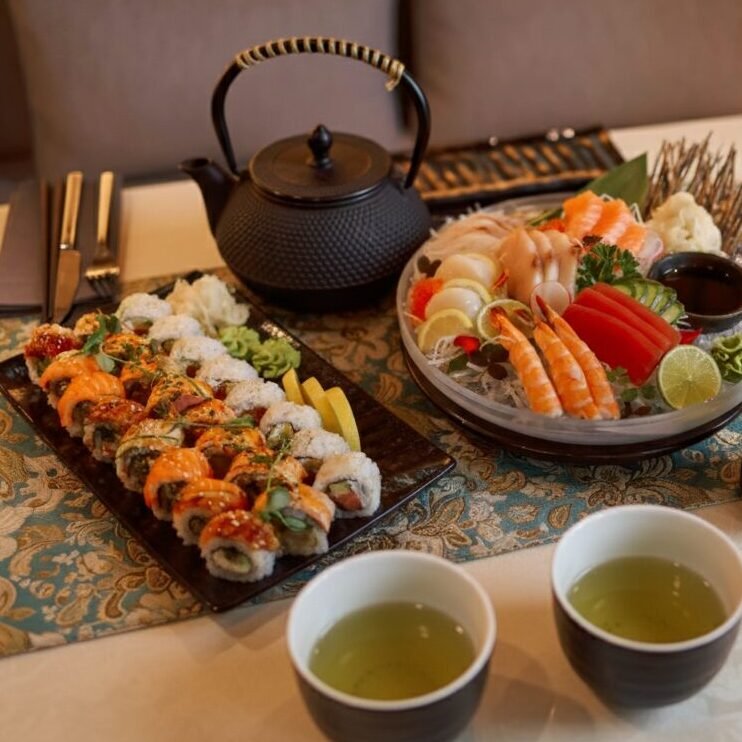
Sushi finds a perfect match in green tea, especially in Japanese cuisine.
According to tea pairing experts at Shizuoka Tea, restaurants typically serve sencha or high-grade varieties like gyokuro with sushi and sashimi. The tea’s grassy and umami notes blend smoothly with the flavors of seaweed, rice, and raw fish. At traditional sushi restaurants, konacha, made from smaller fragments of sencha leaves, serves as “agari,” a palate cleanser between courses because of its bitter taste.
Chefs and diners value this tradition since green tea works well to cleanse your palate between bites.
People drinking green tea with sushi also enjoy a healthy, harmonious pairing. Gyokuro and rich sencha contain high levels of umami that complement soy sauce, tuna, salmon, or oysters on a sushi platter. This combination highlights taste while keeping the meal light compared to heavy drinks like milk or beer.
Green Tea with Tempura

Green tea cleanses the palate after each bite of deep-fried tempura, making this pairing a staple in Japanese cuisine.
Matcha stands out for its umami notes and balances the rich, crispy textures found in shrimp or vegetable tempura. The antioxidants in green tea add health benefits to the meal, while its grassy aroma enhances hot dishes fresh from smoking oil.
Pouring water heated to 175-185°F (~80-85°C) over quality loose-leaf green tea brings out subtle flavors that complement fried foods without overpowering them.
Cracker-like crunch from tempura coating meets light astringency from teas like Sencha or Gyokuro, creating harmony on your palate. Paired with hot sips between bites, green tea cuts through grease and lifts delicate notes often hidden by frying methods similar to those seen with Darjeeling tea beside lighter fare.
Green Tea with Mochi and Wagashi
Pairing green tea with mochi and wagashi highlights centuries of Japanese tradition.
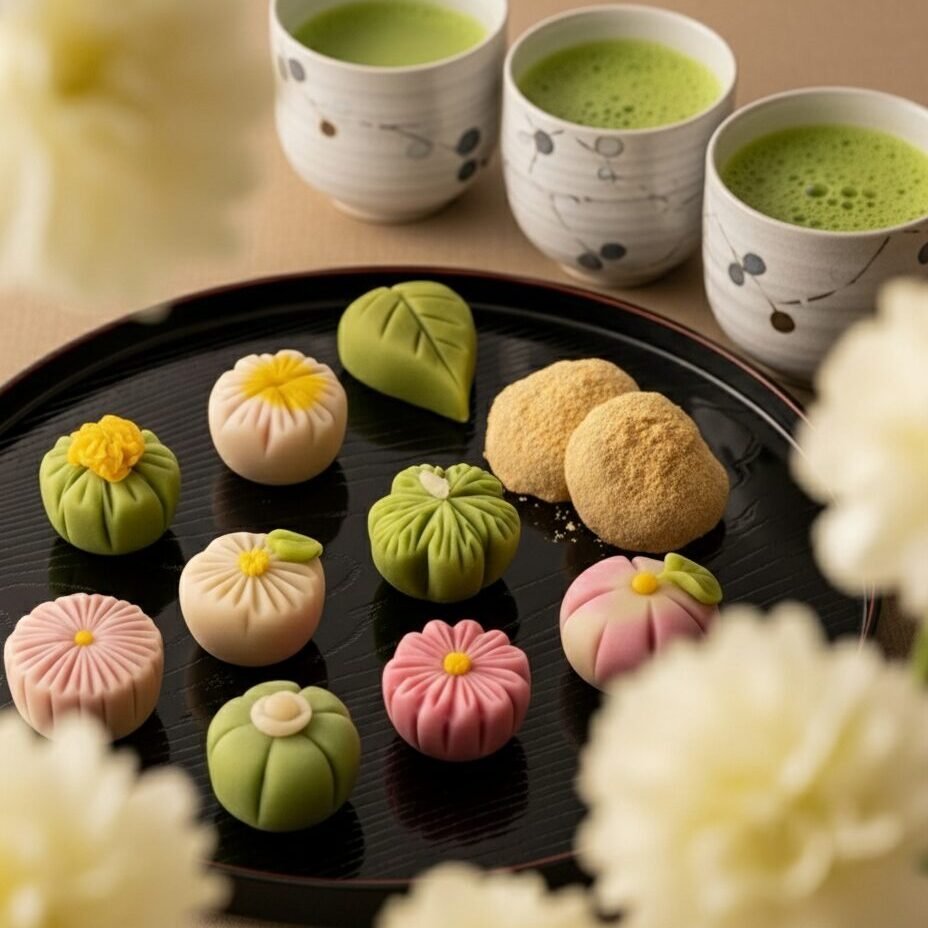
Tea ceremonies often feature these sweets as the original tea food pairing. Wagashi, which includes treats made from bean paste or rice flour, balance the grassy and umami notes in Matcha and Sencha. The subtle sweetness of mochi smooths out any astringency in high-quality teas while letting delicate flavors stand out.
Matcha’s bold character stands up well to rich, chewy mochi and intricately flavored wagashi.
Proper brewing techniques make a big difference. Hot water around 175°F (~80°C) releases enough umami without making teas too bitter for these pairings. Foods deep frying or cracker snacks do not match this careful harmony because their strong tastes can overpower both the drink and sweet treat.
This idea of “mariage,” or balancing taste profiles, has shaped Japanese hospitality since ancient times.
What Breakfast Foods Go with Green Tea?
You can start your day by pairing green tea with breakfast foods that highlight its clean, grassy flavors.
Let me show you new morning combinations that bring out both the tea’s character and your meal’s taste.
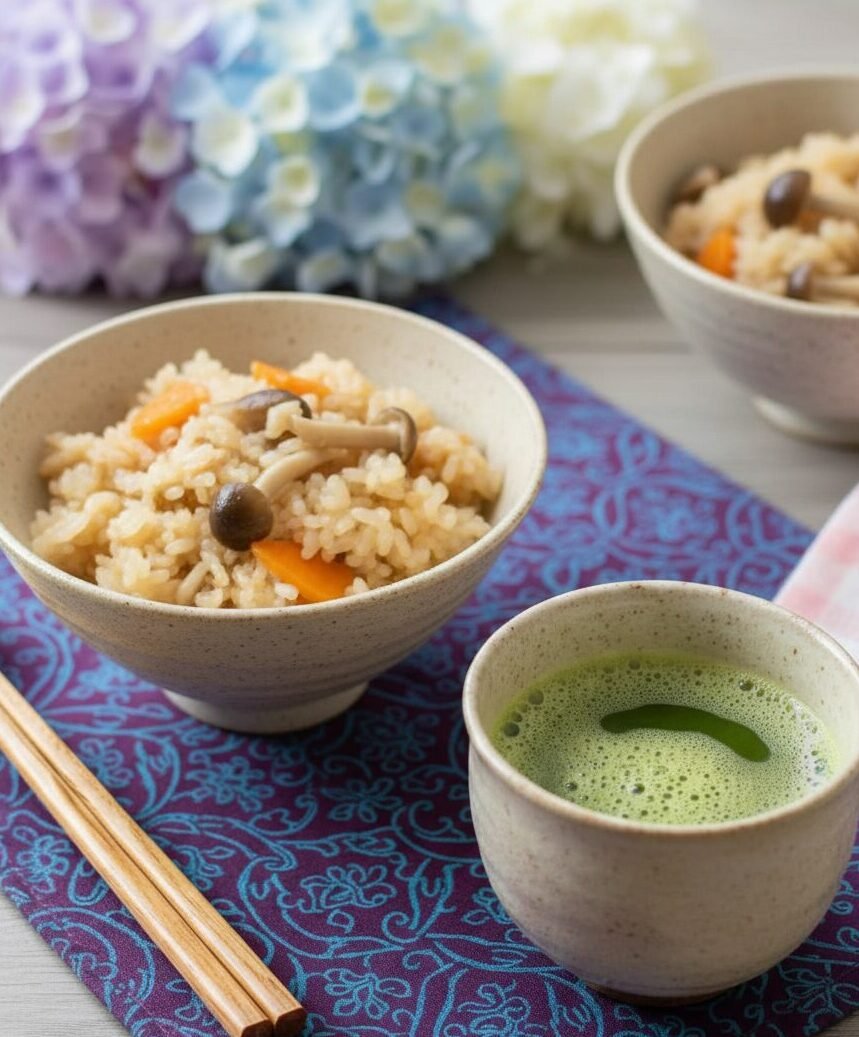
Green Tea with Rice Dishes
Green tea and rice dishes hold a special place in Japanese cuisine.
Genmaicha, made from green tea blended with roasted brown rice, offers a toasty aroma and mild flavor that pairs well with plain steamed rice or ochazuke. Ochazuke is a breakfast meal where hot tea pours over cooked rice. Low caffeine levels and gentle sweetness make Genmaicha suitable for morning meals.
Traditional pairings like Sencha with simple white rice highlight the grassy notes of the tea while enhancing umami flavors in both components.
Matcha also complements savory rice bowls due to its thick texture and vegetal taste. Chefs pay close attention to preparation methods since presentation forms an integral part of this pairing’s cultural significance.
Green tea’s antioxidants support metabolism when taken alongside carbohydrates like rice in daily meals.
Green Tea with Light Pastries
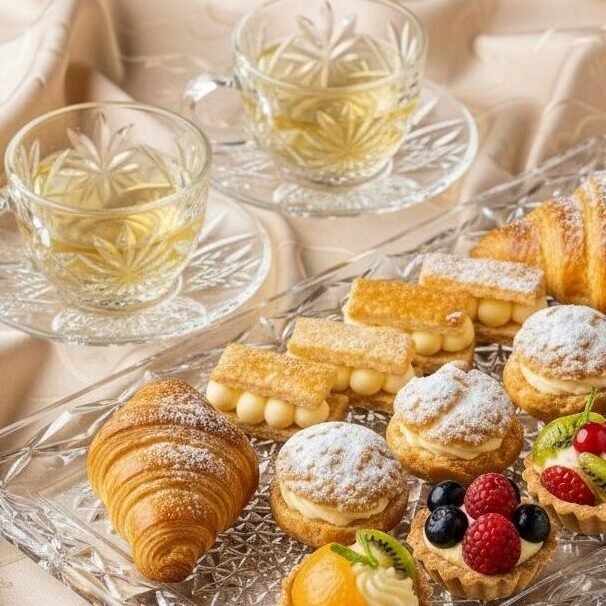
Pairing green tea with light pastries such as almond croissants or fruit tarts creates a refined breakfast experience.
The antioxidants found in green tea help balance the sugars present in mild pastries, making this combination both enjoyable and a healthier option to start your day. Light pastries highlight the grassy notes and subtle sweetness of many green teas.
You may notice how the delicate flavors of hot green tea uplift mild baked goods instead of overpowering them.
This pairing suits both casual mornings and formal occasions, appealing to anyone who appreciates a harmonious meal. Many drinkers find that serving lightly sweetened or fruity pastries with their morning cup brings out hidden umami tones in Japanese varieties like Sencha or Gyokuro.
Green Tea with Fresh Fruit
Green tea pairs beautifully with fresh fruit at breakfast.
Citrus fruits like oranges and lemons add brightness to the subtle grassy taste of green tea. Their tangy notes help highlight the vegetal and umami flavors in your cup. Fresh mangoes, apples, bananas, strawberries, or grapes offer sweetness that balances green tea’s light astringency.
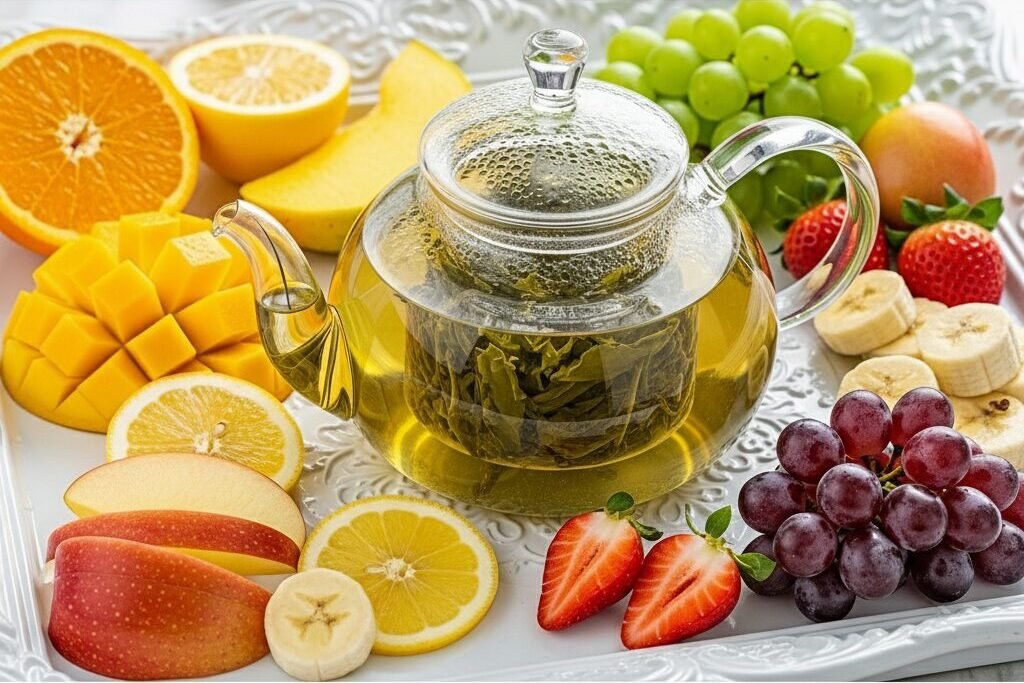
This pairing also boosts nutrition.
Crisp fruit slices alongside green tea can increase antioxidant intake for the day. Both green tea and fruit provide vital nutrients without adding heaviness to your meal. Many people enjoy this combination as a healthy snack option too.
You might notice how eating juicy strawberries or crisp apple bites with each sip makes every mouthful feel more vibrant.
The boost from vitamin C in those fruits may even support absorption of helpful compounds from the tea itself according to several scientific studies.
How to Pair Green Tea with Lunch and Dinner
Green tea adds depth to both lunch and dinner, enhancing each bite with its grassy notes.
Let me show you how different meal techniques highlight the subtlety that comes to tea at your table.
Green Tea with Salads

Fruity green tea lifts the taste of salads by adding natural sweetness without overwhelming delicate greens.
Earthy, vegetative teas match well with vegetarian salads and even mild green curries, highlighting plant-based flavors often enjoyed in healthy lunches. Pairing this tea creates a balanced meal that feels light yet satisfying.
The subtle notes of green tea blend smoothly with fruit salads or fresh sandwiches, making it a popular choice for lunch at both casual tables and formal settings.
A glass of unsweetened green tea enhances leafy vegetables while supporting a nutritious diet.
Green Tea with Steamed Fish
Green tea brings out the fresh taste and subtle sweetness in steamed fish.
Salmon, cod, and tilapia each match well with the grassy and delicate aroma of green tea. The light body of the tea highlights the gentle texture of fish, never overpowering the dish. This pairing is a favorite in Asian cuisine, often seen in Japan and China, for its harmonious flavors and clean finish.
Health-conscious diners favor green tea and steamed fish together for their proven health benefits.
Polyphenols in green tea and omega-3 fatty acids in fish support heart health and overall wellness. Many families choose this refined pairing for nutritious dinners, valuing the way both the fish and the tea enhance each other’s natural flavors.
Green Tea with Chicken Dishes
Smoky green tea balances the richness of chicken dishes.

This pairing is popular in Chinese cuisine, where people value both flavor and aroma. Pan-fried or grilled chicken benefits from the grassy notes and light astringency found in many green tea types. With grilled or roasted methods, smoky teas highlight the meat’s juiciness and bring a new layer of taste to simple recipes.
Sweet chocolates, especially with smoky green tea and chicken, tend to clash, so it is best to avoid them during your meal.
Instead, focus on how green teas add complexity without overwhelming chicken’s delicate flavor. Both chicken and tofu work well here due to their mild profiles, allowing you to enjoy subtle umami and sweetness from the tea itself.
Green Tea with Tofu
Green tea and tofu form a balanced food pairing, especially for those who enjoy plant-based meals.
The light, grassy taste of green tea highlights tofu’s delicate flavor and smooth texture. Tofu absorbs sauces well but never overpowers the tea’s subtle astringency or slight bitterness. Both hot and iced green tea work well with tofu dishes like stir-fried tofu bowls or chilled tofu salads.
This combination appeals to health-conscious diners.
Green tea provides antioxidants while tofu supplies protein and nutrients for a satisfying, nutrient-packed meal. Japanese cuisine often serves green tea with tofu side dishes because the flavors support each other without competing.
What Desserts Complement Green Tea?

The right dessert can bring out new notes in your green tea, making each sip more vibrant.
Let me share these harmonious green tea food pairings to elevate your sweet moments.
Green Tea with White Chocolate
Pairing green tea with white chocolate creates a delicate and balanced dessert that suits both casual afternoons and elegant dinners.
White chocolate pairs best with matcha’s earthy taste, as the creamy sweetness offsets any bitterness while ensuring the cookies remain a delectable treat. White chocolate lifts the subtle flavors of green tea, allowing its grassy notes and gentle astringency to shine through without overpowering them.
Try sipping sencha or gyokuro with white chocolate truffles for a refined treat.
This pairing works well with matcha-infused pastries covered in white chocolate or even simple fruit dipped in melted white chocolate served alongside hot green tea.
Green Tea with Fruit-Based Desserts
Fruit-based desserts highlight the delicate flavors of green tea.
A sip of sencha or dragon well after a bite of fresh peach tart brings out grassy and floral notes in the tea, while the fruit’s natural sweetness softens any hint of astringency. People enjoy pairing green tea with fruit tarts, berry pies, or citrus salads for both formal dinners and relaxed snacks.
The bright freshness from tropical fruits like mango or pineapple contrasts nicely with the earthy flavor profile in most green teas.
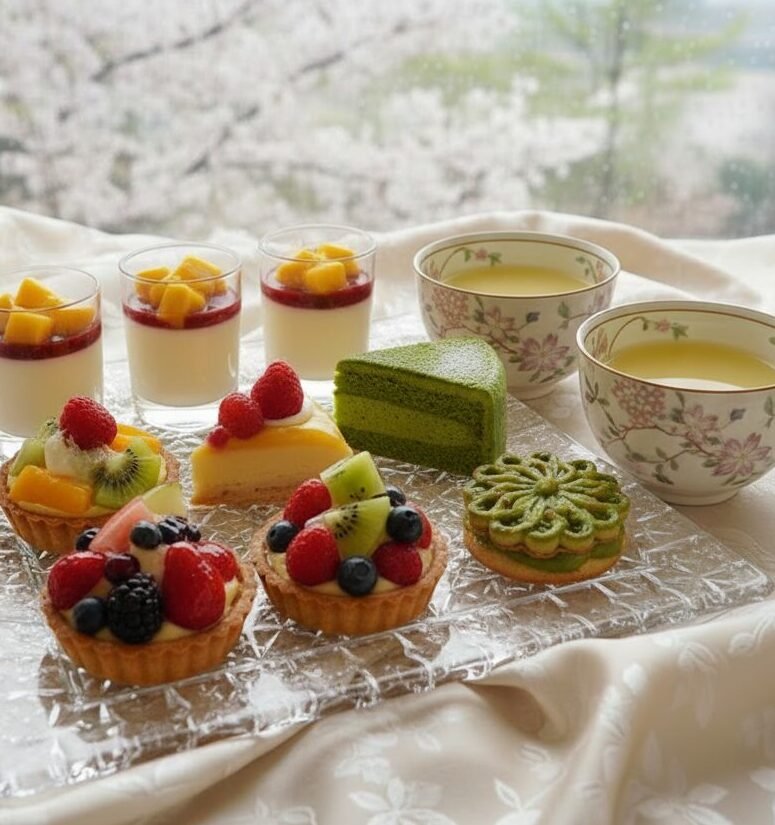
I often suggest matching unsweetened green tea with classic desserts such as apple crumble, strawberry parfaits, or a bowl of mixed melon cubes. This combination lets you savor more health benefits because both green tea and fruits contain lots of antioxidants. It also creates a refreshing experience when you serve chilled green tea next to fruit smoothies or juice-based treats during hot weather.
Green Tea with Mild Pastries
Pairing green tea with mild pastries, such as sponge cakes or almond croissants, elevates your dessert course into something both balanced and enjoyable.
The gentle flavors of these light desserts do not overshadow the grassy and vegetal notes of green tea. Matcha-flavored treats work especially well because their subtle sweetness unites perfectly with the astringency in the tea. Almond croissants add a nutty richness that complements green tea’s umami undertones.
Green tea’s antioxidants pair nicely with the sugars found in pastries, creating a harmonious taste without overwhelming your senses.
Serving this duo for afternoon tea delivers a refined experience that encourages slow savoring. Light, airy cakes form an excellent match for delicate Japanese greens like Gyokuro or Sencha at dessert time.
What Foods Should You Avoid with Green Tea?
Greasy and deep-fried meats can overpower fruity green teas.
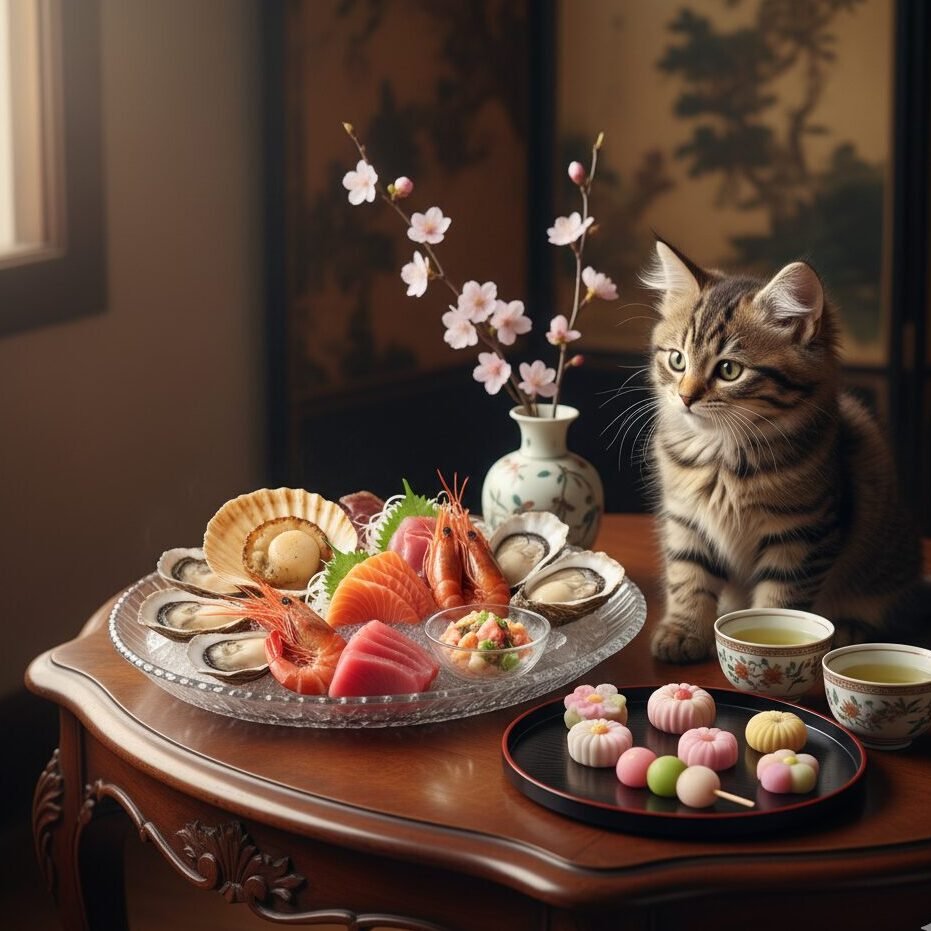
Strong oils and intense flavors often mask green tea’s delicate notes. A good example would be pairing fried chicken or pork belly with a floral or fruity Sencha. The richness from the fat will clash with the freshness of the tea, ruining the balance and making both taste less pleasant.
Certain sweet chocolates, especially when paired with smoky green teas, do not work well together.
For instance, a dark chocolate dessert with a strong smoky Longjing can turn bitter on the palate. Roller fixation during processing increases bitterness in some green teas, making them less suitable with mild pastries or sweet foods such as light cookies or mochi.
Pay careful attention to food choices that might overshadow green tea’s unique flavor profile.
Strongly spiced foods, overly sweet items, and bold sauces may drown out subtle umami or grassy notes in your cup. Focus your pairings on foods that allow the natural taste of your favorite variety to shine through for better enjoyment.
Conclusion: Mastering Green Tea Food Pairing
Pairing green tea with food lets you discover bright new flavors at every meal.
Matching the right green tea variety with each dish can highlight both the tea and your food. Try pairing light meals, seafood, or delicate desserts with these teas to bring out their best qualities. Each sip invites a deeper appreciation for tea culture and healthy eating.
Enjoy the journey and experiment until you find your favorite green tea food pairings.
FAQs
1. What foods generally pair best with green tea?
Green tea’s grassy, light-bodied profile pairs beautifully with lighter-tasting foods. Its primary role is to complement, not overpower. Think of light meals like salads, steamed vegetables, and simple chicken or tofu dishes. It is especially well-suited for seafood, including grilled fish, tempura, and sushi, as its clean taste cuts through richness and cleanses the palate.
2. Does the type of green tea matter for pairing?
Yes, absolutely. Treating all green tea as one flavor misses the best pairings.
- Sencha: With its grassy, balanced flavor, it’s a classic with sushi, sashimi, and grilled fish.
- Gyokuro: This tea has a deep, savory umami flavor. Pair it with other umami-rich foods like soy-sauce-based dishes, tuna, oysters, or even parmesan cheese.
- Dragon Well: Its nutty, toasty notes are excellent with light seafood, chicken, or mild, nutty pastries.
- Jasmine Green Tea: The floral aroma pairs wonderfully with seafood, spicy dishes (like Thai curry), and other aromatic foods.
3. What desserts actually pair well with green tea?
While you should avoid overpowering, sugary desserts, green tea is a fantastic match for more delicate sweets. Its slight astringency cuts through richness and balances sweetness. Try pairing it with:
- White chocolate
- Fruit-based desserts like peach tarts or apple crumble
- Mild pastries such as almond croissants, mochi, or light sponge cakes
4. What foods should I avoid pairing with green tea?
You should avoid any food that will completely overpower the tea’s delicate, complex flavors. The main culprits are:
- Greasy and heavy foods, such as deep-fried red meats or rich, creamy pasta dishes.
- Strong, sweet chocolates, particularly dark or milk chocolate, which will clash with the tea’s grassy notes.
- Overly strong spices, which can drown out the tea (though floral teas like Jasmine can be an exception).
5. Does how I brew my tea affect the food pairing?
Yes, this is one of the most important factors. If you brew green tea with water that is too hot or steep it for too long (more than 3 minutes), it will become bitter and astringent. This bitterness will clash unpleasantly with your food. To ensure a successful pairing, brew your tea at the correct temperature—generally between 160°F and 185°F (71–85°C)—to preserve the sweet and savory umami (Theanine) flavors.
References
- https://www.theenvironmentalblog.org/2025/07/what-does-green-tea-taste-like/ (2025-07-30)
- https://pmc.ncbi.nlm.nih.gov/articles/PMC10740047/
- https://pmc.ncbi.nlm.nih.gov/articles/PMC10529516/
- https://www.inherigin.com/blogs/news/what-pairs-well-with-green-tea-the-ultimate-guide-to-perfect-food-pairings
- https://www.japanesegreenteain.com/blogs/green-tea-and-health/10-foods-to-pair-green-tea-with?srsltid=AfmBOopHyoPnm7WwXlxc6GjdqfbjMmCX5rXfVgOKvaOa27eOG1EUXzg8
- https://intastebudswetrust.com/2018/02/24/fish-and-tea-please/ (2018-02-24)
- https://www.japanesegreenteain.com/blogs/green-tea-and-health/10-foods-to-pair-green-tea-with?srsltid=AfmBOoqxlK3WOpUySf8k5AZoH43k4L_HgF-Mr9RZtYKOi4HtL5Bm8tRA
- https://www.japanesegreenteain.com/blogs/green-tea-and-health/10-foods-to-pair-green-tea-with?srsltid=AfmBOopoMO01PLD-J8K5iStiJKV3P_SgM69JeLmFutBwZiV86KSLs7QM
- https://sacredplantco.com/blogs/natures-pharmacy-exploring-the-historical-uses-and-health-benefits-of-medicinal-herbs/savoring-sencha-perfect-food-pairings-for-your-japanese-green-tea-experience?srsltid=AfmBOoofA_u8Idi-8TMp5mwe6LEgbYq3g63uw9XlbWOArHybtyDpe4IU
- https://mizubatea.com/blogs/news-1/hosting-with-japanese-green-tea-try-these-5-teas-and-food-pairings-when-you-entertainin-guests?srsltid=AfmBOopPADTHEB3gMqJQ724fG4o0oxhPxS08b_oMVEDxBld7xXhGKf0U (2024-01-31)
- https://www.ohhowcivilized.com/tea-pairing-101-green-tea/ (2020-04-29)
- https://www.genuinetea.ca/blogs/blog/pairing-foods-with-jasmine-green-tea-a-comprehensive-guide?srsltid=AfmBOooybI3F1TRpz9m2BafrTUlyy3GXsTEdHZ9oVWtE9pBxlHAbXUhA (2023-07-18)
- https://www.japanesegreenteain.com/blogs/green-tea-and-health/10-foods-to-pair-green-tea-with?srsltid=AfmBOopsXUvlvfLJYBZgH223xUZyWtqXYkmtBsk44p5TM9y0jWlminkF
- https://www.myjapanesegreentea.com/pairing-japanese-green-tea-with-food
- https://www.japanesegreenteain.com/blogs/green-tea-and-health/10-foods-to-pair-green-tea-with?srsltid=AfmBOoq6Lt1bSfWMH8JCAjOLEsBC948FoKgAB4n3pmxvSsceTDDQ64b-
- https://www.teacachai.com/tea-and-food-pairings-japanese-green-teas/ (2022-05-23)
- https://pen-online.com/food/the-pairing-of-food-and-green-tea-a-gateway-to-japanese-cuisine/ (2024-02-29)
- https://www.japanesegreenteain.com/blogs/green-tea-and-health/japan-s-greatest-culinary-combo-green-tea-with-rice?srsltid=AfmBOop68cfKHQ6-N8V2lb4mvZuCGDdlWh5M8R69yk5nosUdssQD0NtW
- https://www.japanesegreenteain.com/blogs/green-tea-and-health/10-foods-to-pair-green-tea-with?srsltid=AfmBOooEh3EPxxYuJH3yEKDngNJRVo9lwqOJRXj-YIC7gFLbdiJ5V9K7
- https://www.japanesegreenteain.com/blogs/green-tea-and-health/10-foods-to-pair-green-tea-with?srsltid=AfmBOoohAsOz0mimDRrJaC0DAguS2WjBsXu6qGPcF74tsfvmEouFcMBd
- https://www.japanesegreenteain.com/blogs/green-tea-and-health/10-foods-to-pair-green-tea-with?srsltid=AfmBOop_wr3g6-l47JadHPOGc7rw-KHT-YNOPVvJhPUh5RvqPcR4a7O4
- https://arborteas.com/tea-pairings
- https://www.japanesegreenteain.com/blogs/green-tea-and-health/10-foods-to-pair-green-tea-with?srsltid=AfmBOoqkl1Re6w3U_UGuKM_Zpy3yusljudTmkPzYeJ86KwzaznDWHmKn
- https://camellios.com/blogs/the-camellios-blog/the-best-foods-to-pair-with-green-tea (2023-06-19)
- https://www.japanesegreenteain.com/blogs/green-tea-and-health/10-foods-to-pair-green-tea-with?srsltid=AfmBOoorGfnnVHHTHI5VVHLtkCzdhE20gIlndatX2n9g2xjJpALRFPZm
- https://www.japanesegreenteain.com/blogs/green-tea-and-health/10-foods-to-pair-green-tea-with?srsltid=AfmBOopcoEHQaOzrqkXoVMb6bqJOXs85KN6xqFzQWUF7DSN_lR93QjBM
- https://teasperience.com/pairing-tea-with-desserts-a-beginners-guide/?srsltid=AfmBOoqrOG07ZuJ6o2dDJRCr1GY3fxmG_D4eU9iQztcduYSG2CGLqkDC (2025-05-12)
- https://www.japanesegreenteain.com/blogs/green-tea-and-health/10-foods-to-pair-green-tea-with?srsltid=AfmBOorvhWiDsRmXgHZqKCWUPJd7Ld9iXTN8qYsQCbqsKtyHY0cxOKas
- https://www.japanesegreenteain.com/blogs/green-tea-and-health/10-foods-to-pair-green-tea-with?srsltid=AfmBOorKhqFO-GmRo1btDKkFRYuiozo3SlHqGqjitAOpi_XpYmqbSBv2






